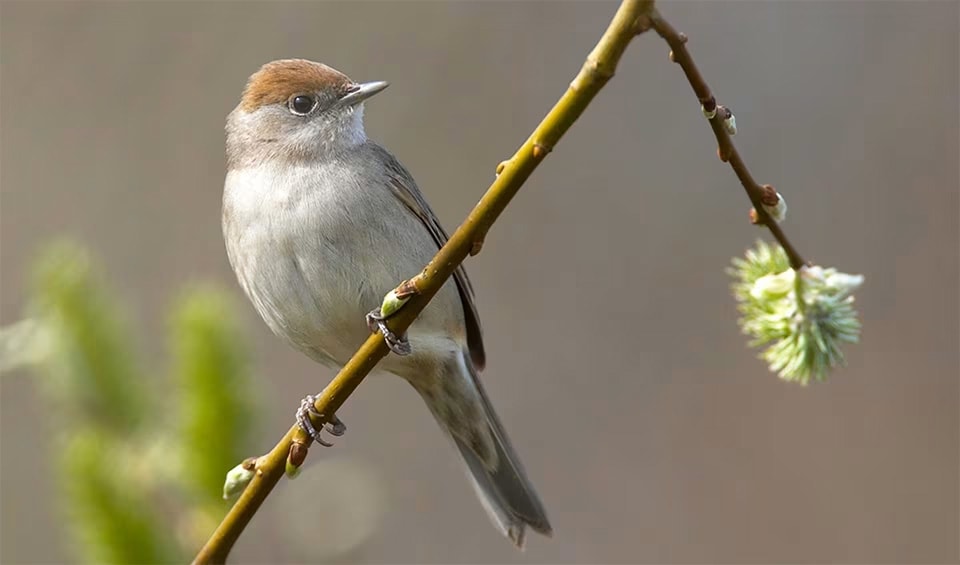A fascinating small passerine bird native to Europe and western Asia, it is celebrated for its distinctive black cap that adorns its head, creating a striking contrast against its otherwise greyish-brown plumage. This unique feature serves as a distinguishing characteristic between the male and female members of this species, with the male boasting a glossy black cap while the female sports a reddish-brown one. Despite this difference, both sexes share a similar overall plumage of greyish-brown tones.
In addition to their striking appearance, Eurasian blackcaps possess a compact build with a slender bill, perfectly suited for their insect-rich diet. These agile birds exhibit a distinctive foraging behavior, characterized by their adept hopping from branch to branch and probing into foliage in search of prey. While insects form a significant portion of their diet, they also readily visit bird feeders, particularly during the harsh winter months when natural food sources may be scarce.
One of the most remarkable attributes of the Eurasian blackcap is its remarkable adaptability to various habitats, ranging from woodlands and forests to gardens and even urban areas. This versatility in habitat selection allows them to thrive across a wide range of environments, demonstrating their resilience in the face of changing landscapes and human encroachment.
The distribution of Eurasian blackcaps extends across Europe and western Asia, where they are widespread and abundant in suitable habitats. While some populations remain resident year-round, others embark on impressive migratory journeys to warmer regions during the winter months, highlighting their remarkable navigational skills and endurance.
Distribution
 Albania
Albania Algeria
Algeria Andorra
Andorra Armenia
Armenia Austria
Austria Azerbaijan
Azerbaijan Bahrain
Bahrain Belarus
Belarus Belgium
Belgium Benin
Benin Bosnia And Herz.
Bosnia And Herz. Bulgaria
Bulgaria Burkina Faso
Burkina Faso Burundi
Burundi Cameroon
Cameroon Cape Verde
Cape Verde Chad
Chad Croatia
Croatia Cyprus
Cyprus Czechia
Czechia Côte D’ivoire
Côte D’ivoire DR Congo (Kinshasa)
DR Congo (Kinshasa) Denmark
Denmark Djibouti
Djibouti Egypt
Egypt Eritrea
Eritrea Estonia
Estonia Ethiopia
Ethiopia Faroe Islands
Faroe Islands Finland
Finland France
France Gambia
Gambia Georgia
Georgia Germany
Germany Ghana
Ghana Gibraltar
Gibraltar Greece
Greece Greenland
Greenland Guinea-Bissau
Guinea-Bissau Guinea
Guinea Hungary
Hungary Iceland
Iceland Iran
Iran Iraq
Iraq Ireland
Ireland Israel
Israel Italy
Italy Jordan
Jordan Kazakhstan
Kazakhstan Kenya
Kenya Kuwait
Kuwait Latvia
Latvia Lebanon
Lebanon Liberia
Liberia Libya
Libya Liechtenstein
Liechtenstein Lithuania
Lithuania Luxembourg
Luxembourg Malawi
Malawi Mali
Mali Malta
Malta Mauritania
Mauritania Moldova
Moldova Mongolia
Mongolia Montenegro
Montenegro Morocco
Morocco Netherlands
Netherlands Niger
Niger Nigeria
Nigeria North Macedonia
North Macedonia Norway
Norway Oman
Oman Poland
Poland Portugal
Portugal Qatar
Qatar Romania
Romania Russia
Russia Rwanda
Rwanda Saudi Arabia
Saudi Arabia Senegal
Senegal Serbia
Serbia Seychelles
Seychelles Sierra Leone
Sierra Leone Slovakia
Slovakia Slovenia
Slovenia Somalia
Somalia South Africa
South Africa South Sudan
South Sudan Spain
Spain Sudan
Sudan Svalbard
Svalbard Sweden
Sweden Switzerland
Switzerland Syria
Syria Tanzania
Tanzania Tunisia
Tunisia Turkey
Turkey UAE
UAE Uganda
Uganda Ukraine
Ukraine United Kingdom
United Kingdom Uzbekistan
Uzbekistan Yemen
Yemen Zambia
Zambia Zimbabwe
ZimbabweAnything we've missed?
Help us improve this page by suggesting edits. Glory never dies!
Suggest an editGet to know me
Terrestrial / Aquatic
Altricial / Precocial
Polygamous / Monogamous
Dimorphic / Monomorphic (size)
Active: Diurnal / Nocturnal
Social behavior: Solitary / Pack / Herd
Diet: Carnivore / Herbivore / Omnivore / Piscivorous / Insectivore
Migratory: Yes / No
Domesticated: Yes / No
Dangerous: Yes / No




